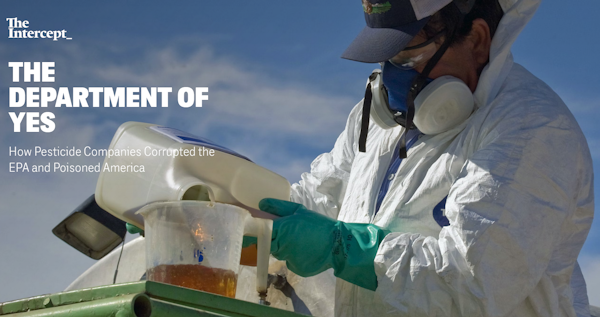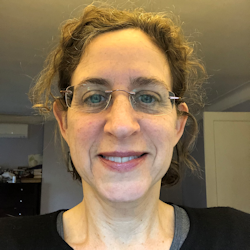SEJournal Online is the digital news magazine of the Society of Environmental Journalists. Learn more about SEJournal Online, including submission, subscription and advertising information.
 |
| A screenshot from Lerner’s award-winning report. |
Inside Story: The Department of Yes — How the Pesticide Industry Corrupted the EPA and Poisoned America
Journalist Sharon Lerner’s detailed investigation of the pesticide industry for The Intercept won the first-place Kevin Carmody Award for Outstanding Investigative Reporting, small category, in the Society of Environmental Journalists’ 21st Annual Awards for Reporting on the Environment. Judges said of the story: “Lerner painted a damning portrait of an agency [the U.S. Environmental Protection Agency] unable or unwilling to carry out its most basic mandate by relying on industry studies and data to approve pesticides despite evidence they were unsafe. … It is laced with shocking revelations about some of the most widely used pesticides in the country, making the case that because of this history of influence, 'countless children and pregnant people' have been exposed to what are now known to be unsafe levels of toxic chemicals."
SEJournal Online recently caught up with Lerner. Here is the conversation.
SEJournal: How did you get your winning story idea?
Sharon Lerner: I was writing about paraquat and came across documents from the 1970s that showed how powerful pesticide companies considered the EPA at the time. Having done a lot of reporting on the agency's current handling of pesticides, I knew that was no longer the case. The question I sought to answer was: What happened between 1970 and now that so weakened pesticide regulation?
SEJournal: What was the biggest challenge in reporting the piece and how did you solve that challenge?
 |
Lerner: The people who were best able to answer the question work for the EPA. Some have since left the agency, but even many of those who were retired or went on to other jobs were reluctant to talk on the record. So it was delicate and slow going.
SEJournal: What most surprised you about your reporting/findings?
Lerner: Once I did start speaking to knowledgeable people, I was struck by how many examples there were of industry influence on the agency successfully weakening regulatory efforts. I was also struck by how integral the companies that make pesticides are to the agency — and how many directors of the OPP [Office of Pesticide Programs] went on to work for the companies they regulated.
SEJournal: How did you decide to tell the story and why?
Lerner: It was a choice between doing many short stories or lumping it all together into one big one, and I chose the latter. It was really a matter of time constraints; we didn't have the bandwidth to publish many little stories. Also, I wanted to get it out quickly.
SEJournal: Does the issue covered in your story have a disproportionate impact on people of low income, or people with a particular ethnic or racial background? What efforts, if any, did you make to include perspectives of people who may feel that journalists have left them out of public conversation over the years?
Lerner: Pesticide exposure disproportionately affects agricultural workers, who are mostly low-income and immigrants.
SEJournal: What would you do differently now, if anything, in reporting or telling the story and why?
Lerner: I might have filed some FOIAs, even though the EPA FOIA office is frustratingly slow and most documents are highly redacted.
SEJournal: What lessons have you learned from your story?
‘I was almost convinced not to do the piece,
but learned that, by talking to many, many
people, it was possible to wrestle this subject.’
Lerner: Many people I spoke to were skeptical that I would not be able to understand and explain the problem of industry influence. I heard that it was too complicated, too technical, etc. I was almost convinced not to do the piece, but learned that, by talking to many, many people, it was possible to wrestle this subject.
SEJournal: What practical advice would you give to other reporters pursuing similar projects, including any specific techniques or tools you used and could tell us more about?
Lerner: That you should reach out to anyone who might be helpful. Yes, it can be awkward — and many times the conversations will be short and useless. But once in a while, they'll have something important to say, so make the call.
SEJournal: Could you characterize the resources that went into producing your prize-winning reporting (estimated costs, i.e., legal, travel or other; or estimated hours spent by the team to produce)? Did you receive any grants or fellowships to support it?
Lerner: It was a low-cost story. No travel, no grants, just a lot of phone calls.
SEJournal: Is there anything else you would like to share about this story or environmental journalism that wasn’t captured above?
Lerner: This is one of many examples of stories about small, technical and seemingly boring decisions written up in dry documents that end up having big consequences. For me, the challenge is to keep my eye on the human part and remember that all the jargon and studies and reports are, in the end, about people.
Sharon Lerner covers health and the environment for ProPublica, having joined it in 2022 after seven years as an investigative reporter at The Intercept, where she focused on failures of the environmental regulatory process, as well as biosafety and pandemic profiteering. Lerner has had her work honored by SEJ 10 times, most recently as the Nina Mason Pulliam grand prize winner of the 2022 SEJ Awards for two stories — "The Department of Yes: How Pesticide Companies Corrupted the EPA and Poisoned America" (discussed in this Inside Story) and "EPA Exposed." She has contributed twice before to Inside Story, with Q&As in 2020 on a race gap in EPA pollution response and in 2018 for a feature on a jailed environmental scientist.
* From the weekly news magazine SEJournal Online, Vol. 8, No. 6. Content from each new issue of SEJournal Online is available to the public via the SEJournal Online main page. Subscribe to the e-newsletter here. And see past issues of the SEJournal archived here.

















